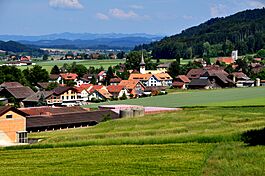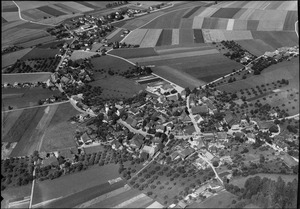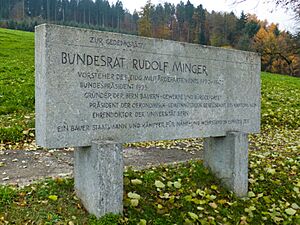Schüpfen facts for kids
Quick facts for kids
Schüpfen
|
||
|---|---|---|

Schüpfen, village from southwest
|
||
|
||
| Country | Switzerland | |
| Canton | Bern | |
| District | Seeland | |
| Area | ||
| • Total | 19.84 km2 (7.66 sq mi) | |
| Elevation | 629 m (2,064 ft) | |
| Population
(Dec 2020 )
|
||
| • Total | 3,792 | |
| • Density | 191.13/km2 (495.02/sq mi) | |
| Postal code |
3054
|
|
| Surrounded by | Diemerswil, Grossaffoltern, Kirchlindach, Meikirch, Münchenbuchsee, Rapperswil, Seedorf | |
Schüpfen is a town, also called a municipality, in the Seeland area of Switzerland. It is located in the canton of Bern.
Contents
History of Schüpfen
Schüpfen was first written about in the year 1208. Back then, its name was Scuphon.
Early Settlements and Rulers
People lived in the Schüpfen area a very long time ago. We know this from old items found from the Mesolithic (Middle Stone Age) and Bronze Age. There are also ancient grave mounds from the Hallstatt culture and La Tene culture. These mounds are like small hills built over graves.
The area continued to be lived in during the Roman times and the early Middle Ages. From 1208 to 1405, a family called Schüpfen ruled the village. They were knights who served powerful lords like the Zähringens and Kyburgs. Schüpfen was an important place for managing the local area.
Changes in Ownership
In 1405, the Lords of Mattstetten took over Schüpfen. They then gave the village and its lands to the Knights Hospitaller. These were a group of knights who helped sick people and travelers. They had a base at Münchenbuchsee Commandery.
Later, in the 14th century, a place called Frienisberg Abbey bought a lot of land in Schüpfen. In 1528, the Abbey's lands became part of the government. Schüpfen then became part of the Bernese area called Frienisberg.
After the French invaded in 1798, Schüpfen was part of the Zollikofen District. Then, in 1803, it moved to the Aarberg District.
The Village Church
The church in Schüpfen was first mentioned in 1268. It was rebuilt in 1741-42. The new church kept its old bell tower from the Middle Ages.
Economy and Transportation
For a long time, farming was the main way people made a living in Schüpfen. Around 1850, many farms started focusing on raising cattle and making dairy products. Today, farming is still important in the smaller villages nearby. Schüpfen itself is a center for trade and light industry.
Better transportation helped Schüpfen grow. A main road connecting Bern and Biel was built between 1835 and 1844. This road linked Schüpfen to bigger towns. A railroad was added in 1864, and a highway in 1983. These good transport links made it easy for people from Schüpfen to travel to Bern, Biel, and Lyss for work or school. In the 1970s, new homes were built for the increasing number of people who traveled for work.
Geography of Schüpfen
Schüpfen covers an area of about 19.83 square kilometers (7.66 square miles).
Land Use in Schüpfen
- About 55.7% of the land is used for farming.
- About 32.9% is covered by forests.
- About 10.7% has buildings or roads.
- A small part, 0.4%, is rivers or lakes.
- Very little, 0.1%, is unproductive land.
Most of the built-up area is for homes and buildings (4.7%) and roads (4.4%). All the forest land is covered with thick trees. For farming, 42.9% is used for growing crops, and 11.7% is for pastures where animals graze.
Location and Villages
Schüpfen is located in the Lyssbach valley. It also sits on the Frienisberg and Rapperswil plateaus. The municipality includes the main village of Schüpfen and several smaller villages and hamlets. These include Bundkofen, Schwanden, Ziegelried, Saurenhorn, Schüpberg, Allenschwil, Wintersschwil, and Bütschwil. There are also many scattered farmhouses.
Schüpfen's Coat of Arms
The description of Schüpfen's coat of arms is: "Red with three silver wings, two facing away from each other and one flat."
Population and People
Schüpfen has a population of about 3,407 people (as of 2023).
Population Changes and Languages
Over the last ten years (2000–2010), the population grew by about 3.9%. Most people in Schüpfen (94.7%) speak German as their main language. A smaller number speak French (1.1%) or Spanish (0.9%).
Age and Family Life
As of 2010, about 21.3% of the population were children and teenagers (0–19 years old). Adults (20–64 years old) made up 63.5%, and seniors (over 64 years old) were 15.1%.
In 2000, there were 1,438 single people in Schüpfen. There were 1,577 married people, 163 widows or widowers, and 140 divorced people.
Housing
In 2000, most apartments (92.2%) were lived in all the time. A small number were used only at certain times of the year (4.3%) or were empty (3.5%).
Historical Population Growth
The chart below shows how Schüpfen's population has changed over time:

Interesting Sights
The entire village of Schwanden and the small village of Winterswil are special. They are part of the Inventory of Swiss Heritage Sites. This means they are important places that should be protected for their history and beauty.
Economy and Jobs
In 2011, the unemployment rate in Schüpfen was low, at 1.13%. This means most people who wanted jobs had them.
Types of Jobs
As of 2008, there were 1,035 people working in Schüpfen.
- Primary Sector: 182 people worked in farming and related businesses. There were 67 businesses in this area.
- Secondary Sector: 197 people worked in manufacturing, mining, and construction. There were 35 businesses in this area.
- Tertiary Sector: 656 people worked in services. This included jobs in sales, transportation, hotels, restaurants, education, and healthcare. There were 99 businesses in this sector.
Commuting to Work
In 2000, 390 workers came into Schüpfen for their jobs. However, 1,305 workers left Schüpfen to work in other towns. This means more people from Schüpfen work outside the municipality than inside it. About 25.3% of workers used public transportation, and 51.4% drove their own cars to work.
Religion in Schüpfen
Based on the 2000 census:
- About 75.9% of the people belonged to the Swiss Reformed Church (a type of Protestant church).
- About 10.3% were Roman Catholic.
- Smaller numbers of people belonged to other Christian churches, or were Muslim or Jewish.
- About 6.72% of the population did not belong to any church.
Education in Schüpfen
Education is important in Schüpfen. About 42.5% of the population has finished high school. Also, 14.6% have gone on to higher education, like a university.
School System
The Canton of Bern has a specific school system:
- One year of optional Kindergarten.
- Six years of Primary school.
- Three years of required lower Secondary school. Students are grouped by their abilities.
- After lower Secondary, students can continue their education or start an apprenticeship (learning a trade on the job).
In the 2009-10 school year, 380 students attended schools in Schüpfen.
- There were 3 kindergarten classes with 46 students.
- There were 11 primary classes with 211 students.
- There were 7 lower secondary classes with 123 students.
In 2000, 27 students came to Schüpfen for school from other towns. At the same time, 138 students from Schüpfen went to schools outside the municipality.
Famous People from Schüpfen
- Rudolf Minger (1881–1955): He was an important politician who served on the Swiss Federal Council (like a government cabinet) from 1929 to 1940. He was even the President of the Swiss Confederation in 1935.
Images for kids
See also
 In Spanish: Schüpfen para niños
In Spanish: Schüpfen para niños









